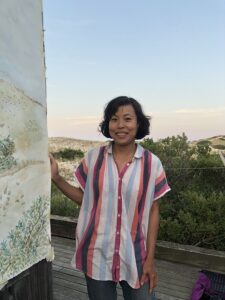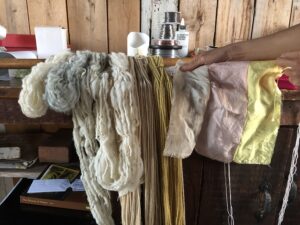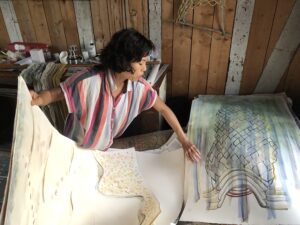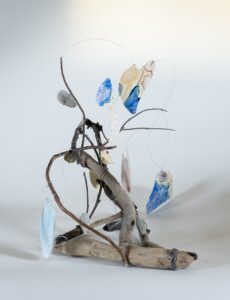Living for three weeks in a dune shack tucked in a hollow by the Atlantic, Lili Chin found the landscape both daunting and inspiring. “There’s a boundlessness that’s almost intimidating,” she said, sitting on the beach in front of the flat and radiantly blue ocean on a late August afternoon. “It’s so beautiful as it is. How do I frame this?”

Chin, a New York-based artist, is a veteran of recent residencies in Scotland and Galveston, Texas and at the Tides Institute in Eastport, Maine.
“In any residency, getting used to a place and your restrictions takes a while,” said Chin. This one, offered through the Provincetown Community Compact, awards a three-week stay in the C-Scape dune shack to an emerging artist of color.
Chin knew the restrictions would be more severe than usual in a shack with no electricity or running water. Working on video, sculpture, and installations, she’s typically dependent on power tools, technology, and specialized equipment to make her artwork. The austerity of this residency posed challenges both practical and existential.
“I feel really bogged down,” said Chin on her way to Provincetown. In addition to her various residencies, in the past year she had her first New York solo show at Microscope Gallery and commuted between New York and Providence, where she teaches in the sculpture program at the Rhode Island School of Design.
“I have so much stuff that has accumulated,” she said. “I want to simplify my life and my art.”

For the first few days, things weren’t so easy. She blasted through all the power on her phone, leaving her disconnected from the world. “That was a real reset,” she said. “I fasted for a day and emptied everything out. I realized there was so much I was consuming. It has been a spiritual experience and a clearing for my practice.”
By the end of her three-week stay, the dune shack experience had done its magic. As they had for many artists before her, the dunes provided both peace and creative focus.
Chin started creating watercolors of the landscape, but the effort to render the place left her feeling frustrated at first. So she focused on experiences like observing a hummingbird or taking a walk to Race Point Beach, followed by a group of seals.
“These memories proliferated and felt a lot more organic than trying to relate to hand-eye coordination,” said Chin. “It feels like a more experiential step into recording a moment.”

Chin had brought a large roll of watercolor paper to the shack, and she set up a studio on the porch. The watercolors of her experiences in the dunes render the place and the creatures in it in simplified, abstracted forms, reminiscent of both Indigenous artwork and American modernism. She plans to use them to develop frescoes.
“I think what’s unique about this place is that I feel really free to do whatever I like,” she said. “I don’t have anybody watching. I’m all by myself. I can take as many risks as I want. I don’t consider myself trained with watercolor at all, and I feel very timid about doing it, but no one’s watching so I can dive into it.”
Chin’s openness to experimenting with materials and approaches is central to her practice. In recent years she has worked with porcelain, ceramics, textiles, fresco, and film — often bringing them together in immersive installations.

In the living room of the shack, strands of wool in subtle colors hung over a bureau. Chin had dyed the wool with plants she found in the dunes: goldenrod, lichen, oak. Hanging on the wall nearby were two netted forms she constructed with found rope. Above, in the second-story bedroom, she had set up about half a dozen sculptures made with wire, driftwood, and shapes cut from her watercolors.
“I like that the sculptures feel ephemeral and contingent,” said Chin. Knowing that she would have limited access to power tools, she had brought wire to create mobiles, one of which was hanging outside the door of the shack. Driftwood allowed her to make more stable structures that could stand on the ground.
“They feel like a comment on my connection with cosmology,” said Chin of the sculptures, whose circular forms and extended shapes recall constellations.
Chin credited the rhythms of nature — so easily observed from the dune shacks — with influencing her sculptures. “The opportunity to be locked into time in such an elemental way is so fertile for the imagination,” she said. “I see the sunrise, the sunset, and then at night I watch the Moon rise.”
She observed the ocean closely, often filming the water from the shoreline. She shot six rolls that she plans to use in a film about the Gulf of Maine. At a residency earlier in the summer at the Tides Institute in Maine, Chin began studying the warming gulf and its effects on marine life.

In Maine she created a short film, Cetacean Blue, with footage of waterways, including some images of this summer’s mass dolphin stranding in Wellfleet. Shot in black and white, the film is a gritty reflection on noise pollution in the ocean. She screened it in August at Farm Projects in Wellfleet, projecting it outside on a torn sail as part of the gallery’s Project Project 2024.
For her next film, which will build on Cetacean Blue but focus more exclusively on her observations at two different ends of the Gulf of Maine, Chin hopes to capture the joy and beauty of her experience living in the dunes while also conveying something about the fragility of the body of water at her doorstep.
“I get attracted to things that are on the verge of falling apart or breaking,” said Chin. “I wonder, where have we gone wrong?”
Her motivations aren’t those of an activist, but she does hope her film will frame the Gulf of Maine in terms that inspire both awe and stewardship. “Activism can only come out of having a real relationship with a landscape that you begin to love,” said Chin. “If it’s coming from a place of rhetoric and theory, it’s not going to go far. But if you spend every day facing a body of water that you end up being completely captivated by, you want to steward it.”



